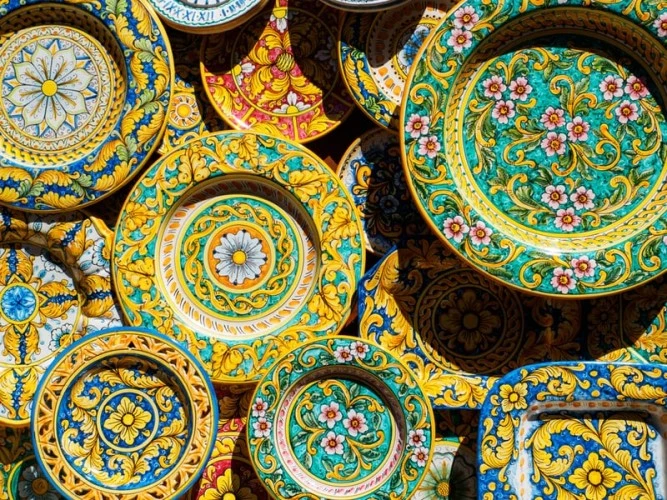Netferry introduces Sicily: the global island

Sicily is a fascinating island. It has a complicated history, which is evident in Sicilian culture and architecture. Today, we all agree that we live in a globalised world, but Sicily has always been a global island and a hub where East meets West, and Europe meets the global south. Sicily's list of invaders contains the usual suspects, the Phoenicians, Carthaginians, Greeks, Romans, Arabs, Byzantines, Spaniards and the Normans. But the three main influences come from the Sicani from North Africa, the Siculi from Latium (Italy) and the Elymni from Greece.
In the 6th century BC, the Greeks conquered the island. In the 8th century BC, the Carthaginians arrived from North Africa, forming a cultural divide on the island and the two major cities, Palermo in the northwest and Catania in the EastEast, battled for dominance. However, the Arabs were the first to establish proper trade, farming and mining in Sicily, they developed the island and made it an attractive prize for European opportunists. The Normans, who formed in France from a group of Viking settlers, took the chance to invade in 1061 and they made Palermo the centre of their growing empire. It subsequently became one of Europe's grandest cities.
During Norman rule, King Roger enjoyed the hybrid Arab-Norman culture in Sicily, indulging in ostentatious architecture and even harems! But after 400 years of pleasure and power, this Norman occupation came to an end, and the kingdom passed to the German House of Hohenstaufen. They were more of an austere bunch and weakened Norman control of the island. In the centuries that followed, Siciliy passed between the Holy Roman Emperors, Angevins (French), Aragonese (Spanish) and the Austrians. This period, characterised by bloody turmoil, ensued until the Bourbons, from Sicily, came along and united Sicily with Naples. The island became part of the Kingdom of the Two Sicilies in 1734.
Then less than a century later, in 1860, Giuseppe Garibaldi planned the dramatic unification of Italy when he arrived in Marsala in Sicily from Genoa in the north of Italy. Once the Bourbons were defeated, and Garibaldi unified the north with the southern regions, including Calabria and Puglia, the south suffered. The new financial arrangements economically benefitted the north and were controlled by The House of Savoy, based in modern-day Piemonte, an alpine region in the far northwest of Italy. Sicily and other southern regions failed to reap the profits of unification, and this economic disparity is still evident today.
The island of Sicily became more and more impoverished. Between 1871 and 1914, before the outbreak of WWI, nearly one million Sicilians emigrated from the island to the USA to escape this dire situation. In the meantime, between 1922 and 1943, Mussolini's regime took hold of Italy. While he was undoubtedly ideologically flawed, his reign saw some efforts to level out the playing field in Italy through the creation of national welfare systems amongst other things; which is why Mussolini remains a contested figure in Italy today. In this period, the American Allies dabbled and played their part in instigating mafia activity in Sicily. The island even became a semi-autonomous region in 1948, when the Americans ushered in the mafia boss, Don Calógero Vizzini to rule. This legitimised and extended mafia control right to the heart of politics. After that, Siciliy was arguably involved in a kind of silent civil war for 50 years, aided and abetted by the mafia trade of cocaine and heroin between Palmero and New York, also known as the pizza connection.
Over time Sicily has made significant progress in straightening out politics on the island, and the battle with the mafia arguably reached its peak in the 1990s, when many high profile court cases took place to hold various bosses to account. However, cleansing mainstream politics of corruption was not without bloodshed; and many anti-mafia pioneers, and their families, were murdered in the process. Sicily is safe for tourists today and in comparison to other parts of Europe like London and Paris, that exist in a constant threat from terrorist attacks, Sicily and the south of Italy are mostly untouched by modern-day terrorism.
When we think about globalisation today, we see southern Mediterranean regions of Europe as politically lacking or having lost out economically. However, southern Europe and places like Sicily, located on the periphery of European economic progress, have other characteristics that aren't quantifiable in percentages and GDP. Their rich cosmopolitan history, beautiful architecture, near-perfect human climate and best diets in Europe make these localities socially valuable and culturally precious. Sicily was one of the earliest places to exhibit the positive influences of multiculturalism and globalisation; therefore Sicily reminds us that these concepts have a long historical trajectory from which we can learn and ascribe a different form of 'value'.
Ferries to Sicily
There are various ferries to Sicily departing from all over Europe. From Malta ferries leave from La Valletta, in Italy departures are from the ports of Salerno, Reggio Calabria, Livorno, Naples, Genoa, Civitavecchia. From Tunisia, ferries leave from Tunis and from France they depart from Nice and Toulon. Visit our website for all the information on arrival and departure times, onboard accommodation and ticket prices.
Netferry: connecting Europe
